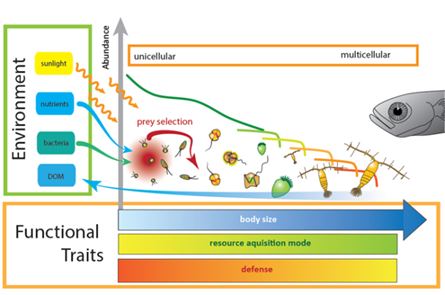While the structure of plankton communities is largely determined by environmental factors such as light, nutrients, temperature and turbulence, details of the structure emerge from the traits and trade-off of its individal members as they stive to reproduce and survive. The unicellular allocation model provides the foundation for primary production and microzooplankton. The full community model will also include multicellular life forms – in particular zooplankton (copepods) that are the main consumers of uncicelluar oganisms, and are in turn preyed on by larger organisms such as fish.
Multicellularity and growth
Multi-cellular organisms are distinct from unicellar in that they grow considerably in size through out their lifetime, often spanning several orders of magnitude. This ontogenic change is size means that the same individual will occupy different trophic guilds through out its lifetime.

Modelling framework
The model resolves three traits: (1) body size that determines predator-prey interactions (big eat small), (2) resource acquisition model (auotrophy, mixotrophy, heterotrophy, cruising or ambush feeding) and (3) investment in defence.